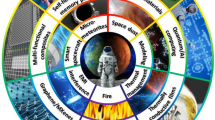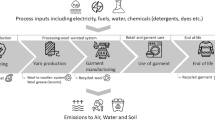Abstract
The life-cycle analysis (LCA) of products is essentially the LCA of materials: both are concurrently and interdependently analyzed and assessed according to their environmental effects. This approach provides a framework to measure the extrinsic environmental properties of materials. In the following, three properties—gross energy requirement, global-warming potential, and solid-waste burden—are broadly discussed for steel, aluminum, and polyethylene. The environmental profiles are then applied to assess the use of alternative materials in terms of the LCA of an automotive component. Given the possibility of a substantial variation in results, one must be careful with the scoping and assessment of LCA. Despite the limitations, it provides a useful map for improving environmental compatibility and performance.
Similar content being viewed by others
References
J.A. Fava et al., A Technical Framework for Product Life-Cycle Assessments (Washington, D.C.: Society of Environmental Toxicology and Chemistry and the SETAC Foundation for Environmental Education, January 1991).
J.A Assies, “Introduction Paper to the SETAC-Europe Workshop on Environmental Life Cycle Analysis of Products” (Leiden, Netherlands, 1991).
Product Life-Cycle Assessment: Inventory Guidelines and Principles, EPA/600/R-92/036 (Cincinnati, OH: Risk Reduction Engineering Laboratory, U.S. EPA, November 1992).
R.G. Hunt, J.D. Sellers, and W.E. Franklin, “Resource and Environmental Profile Analysis: A Life Cycle Environmental Assessment for Products and Procedures,” Environ. Impact Assess. Review, 12(245) (1992).
J.A. Assies, “Towards a General Framework for Life Cycle Assessment” (Paper presented at the IIR Conference on LCA, London, 1992).
R. Heijings, ed., Environmental Life Cycle Assessment of Products, Reports 9266 and 9267 (Netherlands: Leiden University, 1992).
Canadian Standards Association, Environmental Life Cycle Assessment, CAN/CSA-Z 760.2 (Toronto, Canada: Canadian Standards Association, 1994).
A Conceptual Framework for Life-Cycle Impact Assessment (Pensacola, FL: Society of Environmental Toxicology and Chemistry, 1993).
Environmental Resource Guide Subscription (Wahington, D.C.: American Institute of Architects, 1993).
H. Freeman et al., “Industrial Pollution Prevention: A Critical Review,” J. Air and Waste Management Assoc., 42(5) (1992), pp. 618–656.
S.B. Young and W.H. Vanderburg, “A Materials Life Cycle Framework for Preventive Engineering,” IEEE Technology and Society, 11(3) (1992), pp. 26–31.
Responsible Care: A Total Commitment (Ottawa, Canada: Canadian Chemical Producers’ Association, October 1990).
Franklin Associates for the Society of Plastics Industries, Comparative Energy Evaluation of Plastic Products and Their Alternatives for the Building and Construction and Transport Industries (Prairie Village, KS: March 1991).
U. Lenel, “Life Cycle Analysis Explained,” Metals and Materials (November 1992), pp. 589–591.
Battelle Columbus Laboratories, Energy Use Patterns in the Metallurgical and Non-Metallic Mineral Processing, Phase 4—Energy Data and Flowsheets, High-Priority Commodities, USBM OFR 80-7, NTIS PB-245 759 (Washington, D.C.: U.S. Bureau of Mines, June 27, 1975).
P.F. Chapman and F. Roberts, Metal Resources and Energy (Boston, MA: Butterworths, 1983)
G.F. Hancock, “Energy Requirements for Manufacture of Some Non-Ferrous Metals,” Metals Technology, 11 (July 1984), pp. 290–299.
J.T. Houghton, G.J. Jenkins, and J.J. Ephraums, eds., Climate Change: The IPCC Scientific Assessment (Cambridge, U.K.: Cambridge University Press, 1990).
J.T. Houghton, B.A. Callander, and S.K. Varney, eds., Climate Change 1992: The Supplementary Report to the IPCC Scientific Assessment (Cambridge, U.K.: Cambridge University Press, 1992).
D.A. Lashof and D.R. Ahuja, “Relative Contributions of Greenhouse Gas Emissions to Global Warming,” Nature, 344 (1990), pp. 529–531.
V. Ramanathan et al., “Trace Gas Trends and Their Potential Role in Climate Change,” J. Geophys. Res., 90 (1985), pp. 5547–5566.
L.L.D. Harvey, “A Guide to Global Warming Potentials (GWP),” Energy Policy (January 1993), pp. 24–34.
A.R. Ravishankara et al., “Atmospheric Lifetimes of Long-Lived Halogenated Species,” Science, 259 (1993), pp. 194–199.
I. Isaksen, Workshop on Atmospheric Effects, Origins, and Options for Control of Two Patent Greenhouse Gases: CF4 and C2F6 (Washington, D.C.: U.S. EPA, April 1993).
Susan E. Olynyk, private communication, Dofasco, Hamilton, Canada (1 February 1994).
M. Greenfield, “The Reduction, Reuse and Recycle of Wastes Over the Lifecycle of Steel,” Proceedings 32nd Annual of Metallurgists (Quebec City, Canada: CIM, 1992).
“Electrical Power Utilization, Annual Report for 1990” (London: International Primary Aluminum Institute, 1991).
D. Abrahamson, “Aluminium and Global Warming,” Nature, 356 (1992), p. 484.
Workshop on Atmospheric Effects, Origins, and Options for Control of Two Potent Greenhouse Gases: CF4 and C2F6 (Washington, D.C.: U.S. EPA, April 1993).
N.E. Richards, in Ref. 29.
I. Boustead, Eco-Profiles of the European Plastics Industry, Reports 2 and 3 (Brussels, Belgium: European Centre for Plastics in the Environment, May 1993).
C.R. Fussler and B. Krummenacher, “Ecobalances: A Key to Better Material Choices in Automobile Design,” Materials and Design, 12(3) (1991).
U.S. Congress, Office of Technology Assessment, Green Products by Design: Choices for a Cleaner Environment, OTA-E-541 (Washington, D.C.: U.S. Government Printing Office, October 1992).
Life Cycle Design Guidance Manual, Environmental Requirements and the Product System, EPA A600/R-92/226 (Cincinnati, OH: U.S. EPA, January 1993).
Design for Environment, CAN/CSA-Z 762 (Toronto, Canada: Canadian Standards Association, 1994).
M.F. Ashby, Materials Selection in Mechanical Design (Oxford, U.K.: Pergamon Press, 1992).
Report to the National Academy of Sciences Committee on Fuel Economy of Automobiles and Light Trucks (Washington, D.C.: Aluminum Association, 1991).
C.L. Maggee, “The Role of Weight Reducing Materials in Automotive Fuel Savings,” SAE Technical Paper Series, 820147 (1982).
Recycling Scrapped Automobiles, Quick Facts: Issues and Trends, A.D. Little for AISI Automotive Applications Committee, AU10-0B01, 0292-10M-VWA (Southfield, MI: AISI, 1992).
R.L. Ottinger et al., Environmental Costs of Electricity (New York: Oceana Publications, 1990).
Canadian Energy Supply and Demand 1900–2010 (Calgary, Canada: National Energy Board, 1991).
G.P. Arron et al., Environmental Evaluation of Coal, Oil, Natural Gas and Uranium Fuel Cycles: Comparison of Emissions, Wastes and Resources, Report no. 91-225-H (Toronto, Canada: Ontario Hydro Research Division, 1991).
K.S. Yoshiki-Gravelsins, J.T. Toguri, and R.T.C. Choo, “Metals Production, Energy, and the Environment—Part I: Energy Consumption,” JOM, 45(5) (1993), pp. 15–20.
K.S. Yoshiki-Gravelsins, J.T. Toguri, and R.T.C. Choo, “Metals Production, Energy, and the Environment—Part II: Environmental Impact,” JOM, 45(8) (1993), pp. 23–29.
P.R. Atkins, D. Willoughby, and H.J. Hittner, “Some Energy and Environmental Impacts of Aluminum Usage,” Energy and the Environment in the 21st Century, ed. J.W. Tester et al. (Cambridge, MA: MIT Press, 1991), pp. 383–387.
P.D. Stobart, Centenary of the Hall & Heroult Processes: 1886–1986 (London: International Primary Aluminum Institute, 1986).
J.S. Speigel and T.K. Pelis, “Regulations and Practices for the Disposal of Spent Potliner by the Aluminum Industry,: JOM, 42(11) (1990), pp. 70–73.
S.B. Young, unpublished manuscript (University of Toronto, 1993).
Aluminum Standards and Data 1990, 12th edition (Washington, D.C.: Aluminum Association, Inc. 1990).
“Encyclopedia’ 93,” Modern Plastics, 69(13) (1992), p. 262.
Author information
Authors and Affiliations
Rights and permissions
About this article
Cite this article
Young, S.B., Vanderburg, W.H. Applying environmental life-cycle analysis to materials. JOM 46, 22–27 (1994). https://doi.org/10.1007/BF03220669
Issue Date:
DOI: https://doi.org/10.1007/BF03220669




